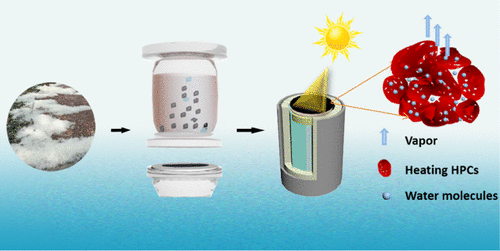Our official English website, www.x-mol.net, welcomes your
feedback! (Note: you will need to create a separate account there.)
Willow Catkins-Derived Porous Carbon Membrane with Hydrophilic Property for Efficient Solar Steam Generation.
ACS Omega ( IF 3.7 ) Pub Date : 2020-02-05 , DOI: 10.1021/acsomega.9b03718 Shaochun Zhang 1 , Linlin Zang 2 , Tianwei Dou 1 , Jinlong Zou 1 , Yanhong Zhang 1 , Liguo Sun 1
ACS Omega ( IF 3.7 ) Pub Date : 2020-02-05 , DOI: 10.1021/acsomega.9b03718 Shaochun Zhang 1 , Linlin Zang 2 , Tianwei Dou 1 , Jinlong Zou 1 , Yanhong Zhang 1 , Liguo Sun 1
Affiliation

|
Biomass wastes are abundant and common in our daily life, and they are cost-effective, promising, and renewable. Herein, collected willow catkins were used to prepare a hydrophilic biochar composite membrane, which was placed in a tree-like evaporation configuration to simulate a natural transpiration process. The strong light absorption (∼96%) of the biochar layer could harvest light and convert it into thermal energy, which then is used to heat the surrounding water pumped by a porous water channel via capillary action. A hydrophilic light-absorber layer remarkably increased the attachment sites of water molecules, thereby maximizing the use of thermal energy. At the same time, hierarchically porous structure and large specific surface area (∼1380 m2 g-1) supplied more available channels for rapid water vapor diffusion. The as-prepared composite membrane with a low-cost advantage realized a high evaporation rate (1.65 kg m-2 h-1) only under 1 sun illumination (1 kW m-2), which was improved by roughly 27% in comparison with the unmodified hydrophobic composite membrane. The tree-like evaporation configuration with excellent heat localization resulted in the evaporator achieving a high solar-to-vapor conversion efficiency of ∼90.5%. Besides, the composite membrane could remove 99.9% sodium ions from actual seawater and 99.5% heavy metal ions from simulated wastewater, and the long-term stable evaporation performance proved its potential in actual solar desalination. This work not only fabricated an efficient evaporator but also provided a strategy for reusing various natural wastes for water purification.
中文翻译:

具有亲水性的Willow Catkins衍生的多孔碳膜,可高效产生太阳能蒸汽。
生物质废物在我们的日常生活中非常普遍,它们具有成本效益,前景广阔且可再生。在本文中,将收集的柳絮用于制备亲水性生物炭复合膜,将其置于树状蒸发结构中以模拟自然蒸腾过程。生物炭层的强光吸收率(约96%)可以收集光并将其转换为热能,然后将其用于通过毛细作用加热由多孔水通道泵送的周围水。亲水吸光层显着增加了水分子的附着位置,从而最大限度地利用了热能。同时,分层的多孔结构和较大的比表面积(〜1380 m2 g-1)为快速的水蒸气扩散提供了更多可用通道。如此制备的具有低成本优势的复合膜仅在1个阳光照射(1 kW m-2)下即可实现高蒸发速率(1.65 kg m-2 h-1),与之相比,提高了约27%未改性的疏水复合膜。具有极佳热局部性的树状蒸发结构使该蒸发器实现了约90.5%的高太阳能转化率。此外,该复合膜可以从实际海水中去除99.9%的钠离子和从模拟废水中去除99.5%的重金属离子,其长期稳定的蒸发性能证明了其在实际的海水淡化中的潜力。这项工作不仅制造了一种高效的蒸发器,而且还提供了一种策略,可以将各种自然废物再利用来进行水净化。
更新日期:2020-02-18
中文翻译:

具有亲水性的Willow Catkins衍生的多孔碳膜,可高效产生太阳能蒸汽。
生物质废物在我们的日常生活中非常普遍,它们具有成本效益,前景广阔且可再生。在本文中,将收集的柳絮用于制备亲水性生物炭复合膜,将其置于树状蒸发结构中以模拟自然蒸腾过程。生物炭层的强光吸收率(约96%)可以收集光并将其转换为热能,然后将其用于通过毛细作用加热由多孔水通道泵送的周围水。亲水吸光层显着增加了水分子的附着位置,从而最大限度地利用了热能。同时,分层的多孔结构和较大的比表面积(〜1380 m2 g-1)为快速的水蒸气扩散提供了更多可用通道。如此制备的具有低成本优势的复合膜仅在1个阳光照射(1 kW m-2)下即可实现高蒸发速率(1.65 kg m-2 h-1),与之相比,提高了约27%未改性的疏水复合膜。具有极佳热局部性的树状蒸发结构使该蒸发器实现了约90.5%的高太阳能转化率。此外,该复合膜可以从实际海水中去除99.9%的钠离子和从模拟废水中去除99.5%的重金属离子,其长期稳定的蒸发性能证明了其在实际的海水淡化中的潜力。这项工作不仅制造了一种高效的蒸发器,而且还提供了一种策略,可以将各种自然废物再利用来进行水净化。











































 京公网安备 11010802027423号
京公网安备 11010802027423号